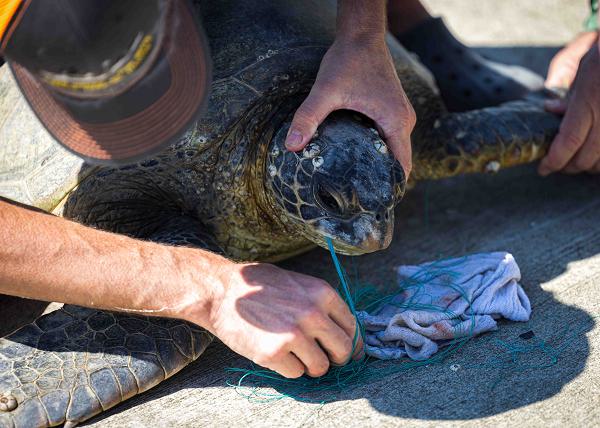
Joint Base Pearl Harbor, Hawaii. (March 24, 2024): You know the U.S. effort to save endangered sea turtles is serious when the Navy gets involved. In this photo by Melvin J. Gonzalvo, Naval staff and civilian specialists from the Pacific Islands Fisheries Science Center complete telemetry tagging of an endangered hawksbill sea turtle. The Naval Facilities Engineering Systems Command Hawaii and the National Marine Fisheries Service have an inter-agency agreement to conduct small boat surveys and turtle capture operations to tag specimens and track their movements. This is the first ever turtle tagging study to document the ranges of Endangered Species Act listed sea turtles inside Pearl Harbor.
Naval Facilities Hawaii, established in March 2005, provides a full range of facilities engineering, real estate, and environmental management services to Navy and other DoD tenants on Hawaii. The command employs over 1,400 highly skilled civilian federal workers plus two hundred military personnel including Navy Civil Engineer Corps Officers, enlisted Seabees, and members of the Air Force 647th Civil Engineer Squadron.
The National Marine Fisheries Service monitors U.S. fisheries of the Pacific Islands and oceanic waters of the central and western Pacific. The Pacific Islands region encompasses the largest geographical area within NOAA Fisheries’ jurisdiction, some 1.7 million square nautical miles. The agency assesses the status of exploited fish stocks and provides scientific advice to fishery managers in the region.
According to the World Conservation Union, the sea turtle is endangered primarily as a result of human fishing practices and that their shells were once the primary source of tortoiseshell material used for decorative purposes.
To help turtle stocks recover, the U.S. Marine Turtle Biology and Assessment Program is conducting research throughout the central and western Pacific Ocean to support the conservation and management of these precious creatures. The agency also researches near-shore island ecosystems, monitors habitats, and even helps remove debris from sensitive areas.
Incidentally, the Hawks Bill turtle nests exclusively in the Hawaiian Islands in very small numbers (likely less than one hundred nesting females). They can lay up to seven nests per season, about two weeks apart, and they lay approximately a hundred golf ball size eggs. Once they leave the nest, they begin the "lost years" phase of their lives and are not seen again in Hawai'i until they reach the size of a hub cap.


